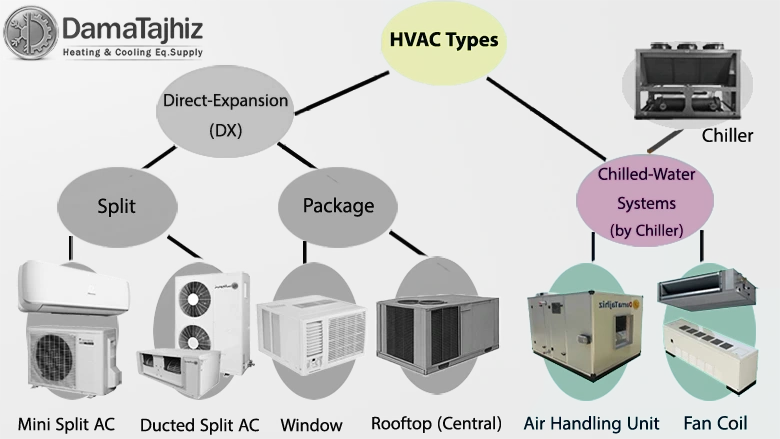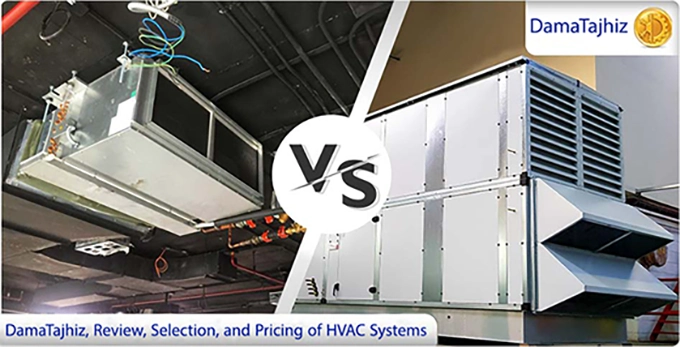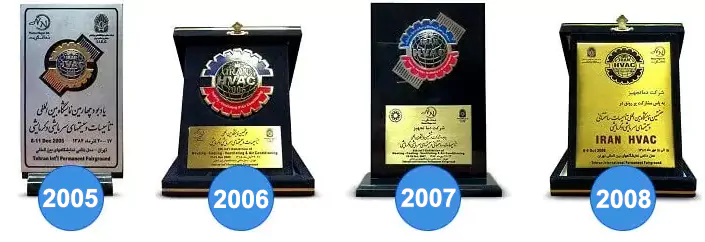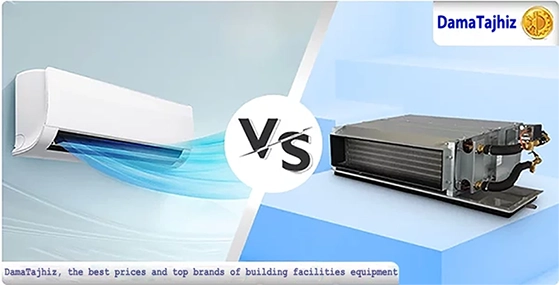Fan coil units and air handling units are both among the most essential components of HVAC systems. FCUs and AHUs are mainly used to regulate indoor temperature and air quality. They both provide heating and cooling. While fan coil units are typically used in smaller, localized spaces with independent temperature control, air handling units are designed for larger areas, offering air filtration, humidity control, and ventilation alongside temperature regulation.
This blog post comprises the advantages and disadvantages of fancoil units and air handling units. Hence, you will first study components, applications, and types of fan coil unit systems; then, there are all of these factors of air handling units. After that, there is a brief comparison of the applications of these two HVAC appliances, investigating their advantages and disadvantages. And finally, you will learn how to calculate an approximate FCU unit capacity. So, stay with us in the following to comprehend fan coil vs air handling unit with an answer to the first question, "What is a fan coil unit?".

Fan Coil Units Components, Applications, and Types
Fan coil units (FCUs) are among the most widely used HVAC systems, providing both heating and cooling for indoor environments. Fan coil unit systems operate by moving air over a coil filled with hot water (in winter) or cold water (in summer) to produce warm or cool air, which is then circulated within the desired space in a building. In this article, we compare fan coil units and air handling units (AHUs), another significant HVAC component, detailing the advantages and disadvantages of each and examining fan coil unit vs air handling unit applications in different settings.
Fan coil units include components such as coils and air-blowing fans, and they come in many types according to their appearance, where they are installed, and how they are intended to be used. The types that are included are floor-mounted, wall-mounted, ceiling-mounted and ducted, and cassette. Fancoils can be categorized into two types based on their internal coils, and these types include the two-pipe system and the four-pipe system, which serve different heating and cooling needs.
Two-pipe fan coil units use one-pipe fan coil units, which use one coil with two cooling coils, which can be provided in hot seasons, and only heating can be provided in cold seasons. In contrast, four-pipe fan coil units have separate heating and cooling coils and provide two pipes each for hot and cold water supply and return. Warm or cool air can be provided simultaneously to different areas in a building by this design, even when seasonal or climate conditions vary.

Air Handling Unit Applications and Performance
AHU systems ventilate and distribute air to specific building areas to achieve comfort conditions for temperature, humidity, and air filtration. An AHU is a component of an HVAC system that brings in fresh outdoor air and filters it through coils to purify it while it heats or cools the air according to the seasons before circulating it indoors through air ducts.
AHUs are generally installed in basements, rooftops, or specific building floors, and they are equipped to bring fresh air from the environment. Unlike fan coils, which are generally installed in the building's internal areas, AHUs are quieter since they are equipped with soundproofing materials and are strategically located away from occupied spaces. It is a clear advantage in comparisons between fan coil units and air handling units for buildings where noise is a concern.

Fan Coil Unit vs Air Handling Unit Comparison in Details
Here is a complete overview of the fan coil unit vs air handling unit. Generally, fan coil units are used year-round to heat and cool spaces requiring independent temperature control and where it's essential to avoid air transfer and potential contamination between different areas, such as residential buildings, offices, healthcare centers, hotels, and more. The relatively low cost and type of fan coil unit systems' capacities and structures make them an attractive option for homes and apartments. However, fan coils might either form part of a larger air conditioning system or support AHU-equipped systems to cover areas of a building that aren't connected to the ducted AHU and HVAC system. The fan coil unit in HVAC setups is thus compared against the air handling unit in terms of versatility and independent control, which becomes essential to determine the best solution for specific requirements.
In the four following sections, there are advantages and disadvantages of the fan coil unit system and air handling unit.
Review, Selection, and Pricing of HVAC Equipment
Advantages of Fan Coil Units
Fan coil units (FCUs) are efficient heating and cooling solutions, particularly in fan coil unit systems. They proffer independent temperature control, space-saving installation, and reduced energy consumption in unoccupied areas. Cost-effective and ideal for smaller spaces, FCUs minimize air transfer between rooms to lower contamination risks. They can also integrate with solar and heat recovery systems, making them versatile for various applications. Overall, FCUs provide significant benefits in managing indoor climates:
- Dual-Functionality: FCUs deliver both cooling and heating, allowing independent temperature control in different spaces within a building.
- Space Efficiency: FCUs require less installation space compared to ducted AHU systems.
- Installation Flexibility: FCUs can be adapted to diverse installations due to their many types, including ceiling-mounted, floor-mounted, wall-mounted, ducted, and cassette units.
- Reduced Energy Consumption: Unused fan coil units in unoccupied spaces can be turned off, lowering energy consumption.
- Lower Installation Costs: Installing FCUs is often more economical than setting up an air conditioning system equipped with an AHU.
- Minimal Air Transfer Between Spaces: FCUs allow reduced air movement between different spaces, minimizing potential contamination spread.
- Compatibility with Small Areas: FCUs are ideal for heating or cooling smaller spaces.
- Solar Compatibility: FCUs are suitable for connection to solar refrigeration equipment or heat recovery systems.

Disadvantages of Fan Coil Units
Fan coil units (FCUs) provide flexibility and efficiency but have some drawbacks. They can cause condensation during cooling cycles, requiring regular drainage maintenance to avoid blockages. FCUs typically do not supply fresh air, limiting ventilation in some spaces. They also require frequent filter maintenance, and cleaning the coils can be difficult, complicating long-term upkeep in HVAC systems. Despite these issues, AC fan coils offer benefits as well.
- Condensation Issues: During summer, condensation may occur as cold water passes through the cooling coil. FCUs require condensate pans and regular maintenance of drainage systems to prevent blockages.
- Limited Fresh Air Supply: Fan coils generally do not provide fresh air (except for those installed near external walls), which can raise questions like "Do fan coil units provide fresh air?" in HVAC planning.
- Filter Maintenance: FCUs have small filters requiring frequent replacement and cleaning to maintain airflow and efficiency.
- Difficult Coil Cleaning: The coil cleaning process in fan coils can be challenging.

Advantages of Air Handling Units
Air handling units (AHUs) provide essential benefits for HVAC systems, including efficient air purification, improved air quality, and protection from external contaminants. They perform well in humid conditions and offer flexible control of temperature and humidity. With durable, corrosion-resistant ductwork, AHUs can be scaled for large spaces and equipped with additional filters, making them ideal for hospitals, offices, and warehouses. Air handling unit (AHU) advantages are:
- Air Purification: AHUs filter, control temperature, and adjust humidity levels, ensuring cleaner and more comfortable air.
- Isolation from External Contaminants: With built-in screens and filters, AHUs prevent external pollution from entering the internal environment.
- Superior Air Quality: Compared to FCUs, which primarily circulate air without purifying it, AHUs significantly improve air quality within a building.
- Durability of Ductwork: AHU ductwork, typically installed above suspended ceilings, tends to be more durable than the floor-mounted piping of fan coils, which is prone to moisture-related corrosion.
- Better Performance in Humid Areas: AHUs outperform FCUs in humid conditions.
- Flexible Temperature and Humidity Control: AHUs can be controlled at different times throughout the day by users.
- Ease of Switching Between Heating and Cooling: Equipped with automatic control systems, AHUs offer simple transitions between heating and cooling modes.
- Advanced Filtration Options: Additional filters (e.g., paper, felt, bag filters) can be added to enhance air quality.
- Scalability: AHUs have flexible dimensions and capacities, allowing them to be installed in large spaces like public buildings, hospitals, office complexes, warehouses, restaurants, and more.
Disadvantages of Air Handling Units (AHUs)
Air Handling Units (AHUs) have some drawbacks despite their effectiveness in ventilation. They require considerable space for ductwork, leading to reduced usable building area, and primarily serve ventilation needs, potentially increasing power use. Additionally, achieving precise airflow and temperature control for each space can be complex.
- Large Space Requirements: AHUs need significant space for ductwork installation, which can reduce usable interior space within the building.
- Ventilation-Only Functionality: AHUs primarily serve for ventilation, so when heating or cooling isn't required, they may contribute to higher electricity consumption.
- Difficulty in Precise Control: Accurately adjusting airflow and temperature in individual spaces can be challenging with AHUs.
A Brief Review of the Differences Between FCU vs. AHU
Fan coils to heat or cool individual rooms, while air handling units (AHUs) are part of larger systems that control temperature, humidity, cleanliness, and air circulation across multiple areas in a building. AHUs include features like humidity control, reheat sections, and filters to prevent outside contaminants, whereas fan coil units (FCUs) circulate air within a single space and do not require ductwork.
AHUs typically have higher initial installation costs due to their size and extensive ductwork. In contrast, FCUs are more cost-effective and come in various designs, making them adaptable to specific needs. While AHUs are quieter due to soundproofing, FCUs may generate more noise since their fans are located within the room.
The following table contains a summary comparison of the fan coil unit vs air handling units.
|
Fan Coil Unit |
Air Handling Unit |
|---|---|
|
No fresh air supply (except FCUs near external walls) |
Supplies fresh, filtered air to the building |
|
Independent temperature control in installed spaces |
No Temperature and humidity control |
|
Smaller size, more design variety |
Larger size |
|
Simpler structure, limited functions |
Complex structure |
|
No ventilation channels (except in ducted FCUs) |
Full air ducting for ventilation |
|
No humidity control |
Equipped with humidity control |
|
Higher noise level for fans inside FCU |
Quieter, with soundproofing |
|
Seasonal temperature requirement only |
Airflow control as to temperature, humidity, and filtration |
|
Useful in smaller spaces |
Useful in larger spaces |
|
Installation indoors requires temperature control |
Installable in basements, on rooftops, or within building floors |
|
- |
Can Be Equipped with Systems Such as Humidifiers, Heat Exchangers, etc. |
AC fan coil units also benefit from reduced space requirements and enhanced flexibility in installation, making them ideal for smaller, isolated spaces where temperature control and energy efficiency are priorities.
Fan Coil Unit vs. Air Handling Unit Overview by DamaTajhiz
It was a complete overview of AHU FCU systems. On the website of Damatajhiz, the first and most reputable online source for purchasing building equipment, you can view the technical specifications of thousands of products, including various fan coils and air handling units. With the guarantee of product authenticity, after-sales service, a valid warranty, and reasonable prices, you can be assured of your choice. For any inquiries regarding brands, comparisons, selections, and purchases of home and office appliances, air conditioning equipment, heating systems, and boiler room equipment, you can consult with Damatajhiz experts during office hours by calling (+98)9302880251.
"Knowledge Fuels Better Choices"
Registered Trademark and Stewardship Business Licenses Issued by the Union of Virtual Business Association and the HVAC Equipment Industry.
DamaTajhiz HVAC Participation at International HVAC and Construction Facilities Exhibitions Demonstrates its Global Reach and Commitment to the Industry.
We Look Forward to Your Call and the Opportunity to Meet With You
SHARE THIS CONTENT TO SPREAD THE KNOWLEDGE
| |








